Food museums can be an entertaining and educational interlude from the typical museum experience. Many of our lives revolve around food, and sampling regional cuisine is a delicious way, most of the time, to learn about the culture of a new place. Everybody eats, and it’s fun to learn what different areas specialize in. This holds true whether it’s Idaho or Italy.
Through food and local eating habits you can discover some new things about the place you are visiting and as a bonus, sample a few nibbles along the way. Most food museums have a gift shop, so if you like what you taste you can take some home to share with friends while you relive your trip. Whether you are looking for laughs or serious enlightenment, here are a few museums to visit.
Idaho Potato Museum – Blackfoot, Idaho, USA
 This museum in Blackfoot, Idaho promises: “We give taters to Out-Of-Staters”. Every adult who purchases a ticket takes home a box of hash browns. How and why exactly did Idaho become so well known for potatoes? Blame it on the Snake River. Potatoes prefer to grow in soil that has a high moisture level, and the weather combined with the river provides just the right environment for potato plants to flourish.
This museum in Blackfoot, Idaho promises: “We give taters to Out-Of-Staters”. Every adult who purchases a ticket takes home a box of hash browns. How and why exactly did Idaho become so well known for potatoes? Blame it on the Snake River. Potatoes prefer to grow in soil that has a high moisture level, and the weather combined with the river provides just the right environment for potato plants to flourish.
The Potato Museum highlights the famous spuds of Idaho. You’ll get a history lesson beginning with the first potatoes planted in the mid-1800s all the way through how the crop was industrialized. You’ll learn how the growing and harvesting process works. There is information about potato nutrition, interesting video presentations, and many other educational facts on display.
Here are some points about potatoes: the average American eats about 124 pounds of potatoes a year; the average German eats twice that amount; Thomas Jefferson introduced French fries to America when he served them at the White House; the largest potato ever grown was 7 pounds 1 ounce; and the world’s largest potato chip is 23” x 14.5”.
>>book a flight to Boise, Idaho
[social]
Washington Banana Museum – Auburn, Washington, USA
 Banana plantations are typically found in hot tropical regions like South America, Southeast Asia, Africa and the Caribbean Islands. So, why is there a banana museum in Auburn, Washington – a cool, wet, northern location? I imagine there isn’t a banana tree in sight. It’s all because of a woman named Ann Mitchell Lovell, and her interest in this special fruit.
Banana plantations are typically found in hot tropical regions like South America, Southeast Asia, Africa and the Caribbean Islands. So, why is there a banana museum in Auburn, Washington – a cool, wet, northern location? I imagine there isn’t a banana tree in sight. It’s all because of a woman named Ann Mitchell Lovell, and her interest in this special fruit.
Ann, who was nicknamed Anna Banana as a child (it has to start somewhere) first became interested in bananas in 1980 on a trip to Hawaii. She bought a t-shirt with the logo of a bar on it. Guess what? The bar was named ‘Anna Bannanas’ (yes, spelled differently.) Ann gradually accumulated more and more banana related things, some she found herself and others were given to her by friends. The collection grew and morphed until she ended up with close to 4,000 banana related items, many of which are on display at Bananas Antiques in Auburn.
Here are a few bits about bananas: the average American eats about 150 bananas a year; in 2001 Britain reported more than 300 accidents relating to bananas – most involved slipping on banana skins; a cluster of bananas is called a hand and consists of 10-20 bananas, which are also known as fingers; the word ‘banan’ is Arabic for finger; and lastly, bananas don’t have any fat, cholesterol or sodium making them a great snack food.
>>book a cheap flight to Washington DC
Dutch Cheese Museum – Alkmaar, Netherlands
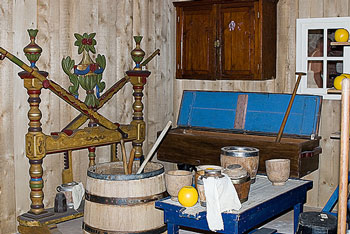 If you’ve ever visited the Netherlands, and been outside of the big city, you’re familiar with the herds of cows that speckle the pastures. There are about 1.5 million of them in the country. That’s a lot of cows, and you’ll notice they all look happy and well fed. That’s where the profitable cheese business begins, with the milk from those plump, healthy beasts.
If you’ve ever visited the Netherlands, and been outside of the big city, you’re familiar with the herds of cows that speckle the pastures. There are about 1.5 million of them in the country. That’s a lot of cows, and you’ll notice they all look happy and well fed. That’s where the profitable cheese business begins, with the milk from those plump, healthy beasts.
In the Dutch Cheese Museum, which is located inside of the Waaggebouw (weighing house) at the Alkmaar cheese market, you’ll learn the country’s history surrounding the production and trade of cheese. You can view a slide presentation and portraits of Dutch women from the 16th century to learn more about traditional life in this country.
You’ll also see old tools and instruments used for cheese making over the centuries. Outside of the museum is the cheese market, where a demonstration is put on daily from April through September. A traditional market is at work here, complete with the cheese carriers in their customary straw hats hauling carts of cheese around the mart.
Here are a few details about Dutch cheeses: cheese has been made in this area since about 200 BC; cheese was traditionally made by women; 60% of the cheese produced in the Netherlands is Gouda; Edam cheese was originally formed into round balls to make it easier to transport on sailing ships and the cheese balls were occasionally used as canon balls.
>>book a cheap flight to Netherlands and read more about Netherlands
Shin-Yokohama Ramen Museum – Yokohama, Japan
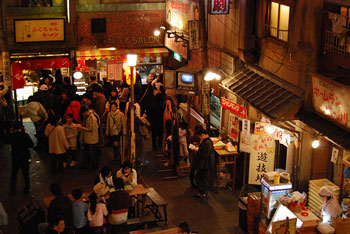 This museum is for the serious ramen lover, or someone who just enjoys wacky food museums. If you’ve never tried ramen, it’s a noodle dish that originated in China centuries ago, in fact a ramen bowl thought to be about 4,000 years old was recently excavated there. Ramen noodles are likely Japan’s favorite national food.
This museum is for the serious ramen lover, or someone who just enjoys wacky food museums. If you’ve never tried ramen, it’s a noodle dish that originated in China centuries ago, in fact a ramen bowl thought to be about 4,000 years old was recently excavated there. Ramen noodles are likely Japan’s favorite national food.
This Ramen museum/amusement park/restaurant opened in 1994. On the first floor you can explore the history of ramen noodles in Japan right up to the really big invention of instant ramen noodles in 1958. There are displays of noodles, toppings, bowls and various utensils all over the place. The walls are covered with ramen packets from all over the world and TV’s play on-going ramen commercials. Kids can play ramen-related video games. Downstairs you’ll discover the food amusement part of the museum, including an assortment of shops selling mini-ramen dishes to sample.
Here’s the reality about ramen: the largest packet of instant noodles ever made weighed over a half ton; there is a special variety of ramen made just for dogs; last year Americans bought just under 400 million packets of ramen; and a package of ramen usually sells for about 12 cents.
>>look for cheap flights to Japan and read our Japan Travel Guide
SPAM Museum – Austin, Minnesota, USA
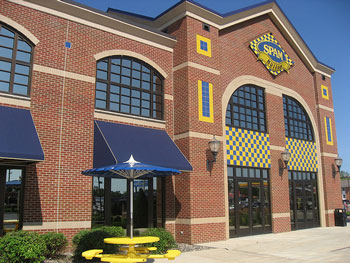 When I was a kid, my mom occasionally made us fried SPAM sandwiches for lunch. They were a big treat and my brother and I loved them. Some memories are meant to be fondly cherished and not relived. This is one of them. What exactly is SPAM? It’s a canned, precooked meat product made out of chopped pork shoulder, ham meat, salt, water, sugar and sodium nitrite that was introduced by Hormel Food Corporation in 1937.
When I was a kid, my mom occasionally made us fried SPAM sandwiches for lunch. They were a big treat and my brother and I loved them. Some memories are meant to be fondly cherished and not relived. This is one of them. What exactly is SPAM? It’s a canned, precooked meat product made out of chopped pork shoulder, ham meat, salt, water, sugar and sodium nitrite that was introduced by Hormel Food Corporation in 1937.
At the SPAM Museum you’ll have the opportunity to learn all about this interesting food. In the 16,500 foot space there are interactive displays, old advertisements, videos, and a lot of information and trivia about SPAM including its role during WWII. There is also a gift shop where you can buy SPAM memorabilia.
Here’s some scoop about SPAM: the seven billionth can was sold in 2007; there are several varieties of SPAM including Hot & Spicy, Hickory Smoke, Bacon, Cheese and Garlic; it’s so popular in Hawaii it’s called the ‘Hawaiian Steak’; SPAM has a mascot – a miniature pig named Spammy; and the world SPAM eating record is set at six pounds in 12 minutes.
>>book a flight to Minneapolis, Minnesota
Cologne Chocolate Museum – Cologne, Germany
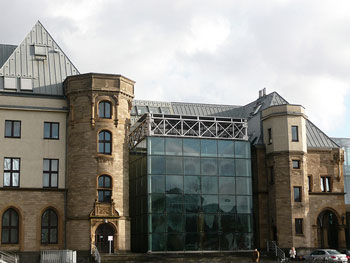 If you are a chocolate lover like me (I consider it one of the basic food groups) you’ll adore this museum. The smell alone will make your mouth water and you will willingly open your wallet for morsels to savor from the gift shop. It is so well done that even those who don’t have a love affair with the cocoa bean will be amazed at the story behind chocolate.
If you are a chocolate lover like me (I consider it one of the basic food groups) you’ll adore this museum. The smell alone will make your mouth water and you will willingly open your wallet for morsels to savor from the gift shop. It is so well done that even those who don’t have a love affair with the cocoa bean will be amazed at the story behind chocolate.
The Chocolate Museum opened in 1993 and over 5 million people visit it each year. As you follow the self-guided tour you’ll learn all about the cacao plant, even seeing live plants in the greenhouse room. There is an explanation of how the plants are grown, how the beans are harvested and the evolution of the machinery used in the process. You’ll find out about the different forms and types of chocolate, and even get to have a taste from a chocolate fountain along the way. For those who want more, more, more (chocolate has been known to have that effect on some of us) they also offer a few classes.
Here is a compilation of trivia about chocolate: Chocolate was first introduced in the U.S. in 1765; a recent study shows that when women crave food they want chocolate; Africa is the world’s leading producer of cacao; historically chocolate was also used for it’s medicinal value; and chocolate does not cause acne.
>>book a flight to Germany and read our Germany Travel Guide
Felino Salame Museum – Felino, Italy
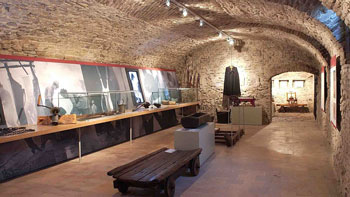 Located in the province of Parma inside the Felino Castle, the museum highlights the history of salame in this region. The Felino Castle was built in 890 and numerous families have maintained strongholds here over the centuries. Several of the castle rooms are used for museum displays and there is also a nice restaurant onsite.
Located in the province of Parma inside the Felino Castle, the museum highlights the history of salame in this region. The Felino Castle was built in 890 and numerous families have maintained strongholds here over the centuries. Several of the castle rooms are used for museum displays and there is also a nice restaurant onsite.
The Salame Museum is divided into five different sections. The first shows the history of salami, centering on the relationship between the black Parma pig and the region. The next section, appropriately located in the kitchen, discusses the importance of salami as a food. Next is a room that documents the process of butchering pork and has a tool display. There is a room that focuses on the sales and marketing aspect of salami and last, you are able to watch films about salami production.
Here are some specifics about salami: September 7 is salami day; ‘salame’ is a generic Italian term describing any kind of encased meat product; salami should be thinly sliced to get the most flavor and aroma; historically salami was popular for Italian peasants because it could be stored at room temperature for up to a year; and ‘salami’ is the plural form of the Italian word ‘salame’.
>>look for airfare to Italy and read about what to eat in Italy
Deutsches Currywurst Museum – Berlin, Germany
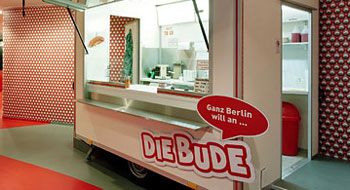 Here’s another museum about encased meat products, only this one is in Germany and celebrates one of their national dishes, currywurst – hot pork sausages covered with a curry sauce made out of ketchup and curry powder. Currywurst is commonly sold as a take-out snack, but you’ll also find it at diners and on children’s menus.
Here’s another museum about encased meat products, only this one is in Germany and celebrates one of their national dishes, currywurst – hot pork sausages covered with a curry sauce made out of ketchup and curry powder. Currywurst is commonly sold as a take-out snack, but you’ll also find it at diners and on children’s menus.
The Currywurst Museum opened in Berlin in 2009 to celebrate the 60th anniversary of the creation of this popular dish. It’s an interactive exhibit involving all your senses. You’ll see a genuine snack bar that you can stand behind to get a feel for what it would be like to own your own currywurst stand, a sausage shaped sofa to sit and ponder the idea on, gigantic french fry displays and a room full of fragrant spices. Who knows, after smelling and looking at currywurst for an hour or two you may find yourself in the mood to taste one, but they don’t sell them at the museum.
Here is what’s what in the world of wurst: back in the 1400’s you could be fined if you stuffed anything “undesirable” into your meat casings; there are about 440 calories in a currywurst; wurst is the second most popular staple in the German diet behind bread; and authentic German beer is the drink of choice to accompany any wurst.
>>book airfare to Berlin
Mount Horeb Mustard Museum – Mount Horeb, Wisconsin, USA
 If you have a sense of humor and enjoy visiting unusual food museums this is one you shouldn’t miss. It was opened in 1992 in Wisconsin by the former Assistant Attorney General, Barry Levenson. He was very upset about the defeat of his favorite team in the 1986 World Series, so he did what many of us might do (although probably not me.) He started a collection. In this case, it happened to be a mustard collection.
If you have a sense of humor and enjoy visiting unusual food museums this is one you shouldn’t miss. It was opened in 1992 in Wisconsin by the former Assistant Attorney General, Barry Levenson. He was very upset about the defeat of his favorite team in the 1986 World Series, so he did what many of us might do (although probably not me.) He started a collection. In this case, it happened to be a mustard collection.
The Mustard Museum has a display of over 5,000 jars, bottles and tubes of mustard from all over the place, including at least one from all 50 U.S. states. It’s also got items related to mustard like mustard pots and tins, ads about mustard and all sorts of memorabilia. The town even has a festival to celebrate National Mustard Day, which is the first Saturday in August.
Here are some minor points involving mustard: mustard has been mentioned in the religious writings of Christianity, Buddhism, Islam, Bahia, Judaism and Hinduism; Canada is the world’s largest producer of mustard seed; all parts of the mustard plant are edible; mustard is thought to have originated in India in about 3000 BC; and New York’s Yankee Stadium uses 1,600 gallons plus 2 million little packets of mustard per year.
>>book a flight to Milwaukee, Wisconsin
Read about author Deanna Hyland and check out her other BootsnAll articles.
Read more about:
- 15 of the Best Small, Quirky, and Unusual Museums in the US
- 13 of the Most Unusual Snack Foods From Around the World
- 10 Bizarre Desserts that Shouldn’t Taste So Good
- 8 of the Best American Small Towns for Foodies
Additional photo credits:
Cheese museum by velodenz on Flickr, Potato museum by jimmywayne on Flickr, Ramen museum by gnurou on Flickr, Spam museum by Bill.Roehl on Flickr, Chocolate Museum by mitko_denev on Flickr